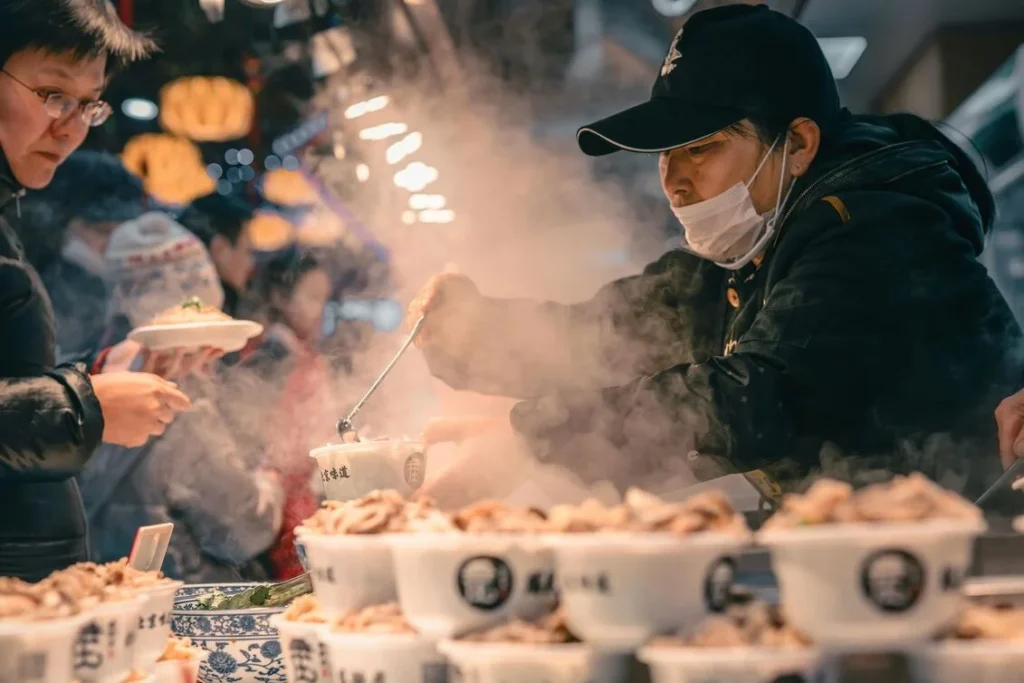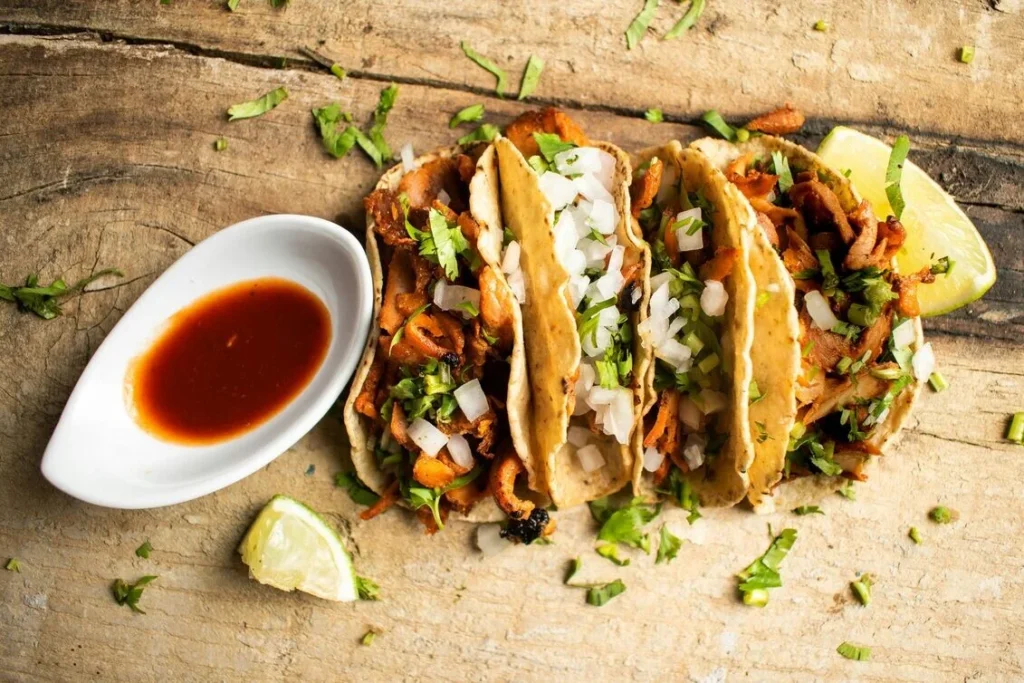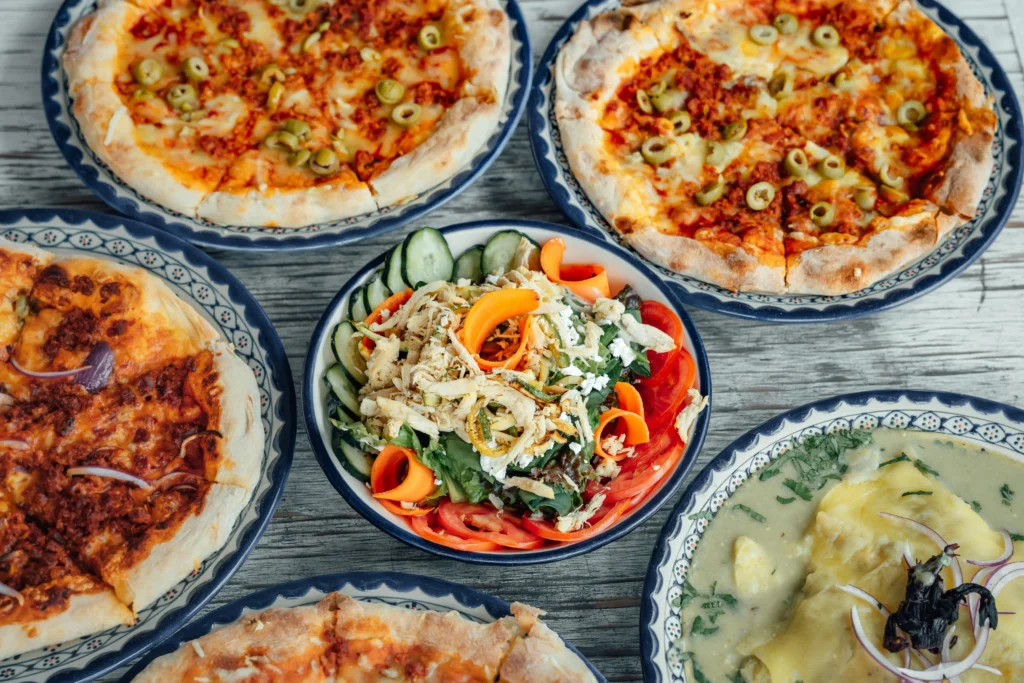From Street Food To Fine Dining: The Evolution Of Global Cuisine

Food has always played a major role in shaping human identity and culture. From the streets of Bangkok to Parisian dining halls, food is both a basic need and a reflection of cultural diversity.
The evolution of global cuisine has come a long way, starting with simple street food and ending with elegant fine dining. Food has evolved to reflect historical, social, and economic changes in our eating, cooking, and food-related experiences.
The Origins of Street Food
The foundation of many culinary traditions is street food. There is evidence of street vendors in ancient Greece, Rome, and China, tracing its beginnings back thousands of years. Street food originated from a need. It supplied working-class people, business owners, and tourists with quick, easy, and reasonably priced meals.
1. Ancient Civilizations and Street Food

Ancient Greece and Rome: Bread, olives, and wine were among the ready-to-eat goods offered at food stands in ancient Greece and Rome.
Street food booths nowadays compared to the thermopolia, which were small stores in ancient Rome that provided hot food.
Since many Romans lacked the means to prepare meals at home, dining on the streets was a typical occurrence.
China: Cheap and portable dishes like soups, dumplings, and noodles street vendors sold in ancient China.
2. Cultural Roots of Street Food
India: The street cuisine of India is deeply ingrained in the country’s culture, and it varies depending on the area. In Delhi and Mumbai, street food vendors offer dishes like biryani, vada pav, samosas, and chaat.
Indian street food bursts with flavor, combining sweet, salty, spicy, and sour elements.
Middle East: The region’s history of migration and trade routes is reflected in its street food. Street food staples like shawarma, falafel, and kebabs are made from time-honored family recipes.
Latin America: Tacos, arepas, and empanadas are vibrant Latin American street foods influenced by indigenous, African, and European cultures.
The historical relevance of street food lies in its simplicity. It needed few ingredients, so merchants could make a lot of food for not much money. Due to its accessibility, people from different socioeconomic backgrounds were able to enjoy the same foods, making it a cultural equalizer.
The Global Influence of Street Food
Street cuisine started to spread internationally as globalization gained traction in the contemporary period. Street food has influenced fine dining due to the diffusion of culinary traditions and cultural customs, driven by human migration. This shift highlights the evolution of global cuisine and the growing fusion of diverse culinary influences in today’s dining experiences.
1. The Globalization of Street Food

People carried their culinary customs with them when they moved to different parts of the world. Tacos, dumplings, and banh mi are just a few of the famous street food fads immigrants from countries like the United States brought to American cities.
The expansion of street cuisine across the globe was also aided by the growth of foreign travel. Street food proved to be a genuine and reasonably priced means for tourists who were keen to immerse themselves in the local customs and traditions.
Street food markets, like London’s Borough Market, developed into major cultural hubs for both locals and visitors, and street food festivals started to appear in cities all over the world.
2. Fusion Cuisine and Street Food’s Influence
Street cuisine gained influence and assimilated into the fine dining scene as it expanded throughout the world. The robust, real flavors of street food gained popularity among chefs, who started blending them into their haute cuisine. Street food and fine dining came together to form a new genre known as “fusion cuisine,” which included ingredients from many culinary traditions.
Famous chefs like Roy Choi were instrumental in starting this fusion trend. Inspired by LA’s street food scene, Choi’s well-known Korean-Mexican taco truck, Kogi, changed people’s perceptions of street cuisine by fusing Mexican tacos with Korean BBQ ingredients. The way that street food has influenced fine dining indicates how people are becoming more appreciative of real, flavorful foods that defy the conventions of traditional, Western-style fine dining.
The Evolution of Fine Dining
Street food has a more casual and relaxed past than fine dining. Traditional fine dining features intricate preparation, rare ingredients, and formal etiquette, reflecting class and hierarchy. Over time, fine dining has evolved to incorporate international, casual, and street cuisine-inspired elements, showcasing the evolution of global cuisine and how cultural influences have reshaped dining experiences worldwide.
1. The Origins of Fine Dining

Fine dining originated in European aristocracy, where formal meals showcased social status.
Especially French food, which was characterized by elaborate multi-course meals, silver service, and pricey ingredients as the foundation of what was called “haute cuisine,” came to be associated with fine dining.
Italian food likewise rose to prominence in the Renaissance and was greatly valued by the nobility. Rich feasts with unusual cuisine and elaborate presentations were typical. Noble households employed chefs to make extravagant feasts that were regarded as demonstrations of their riches and sophistication.
2. The French Influence on Global Fine Dining
French chefs such as Auguste Escoffier, who established the brigade system a hierarchical kitchen organization that is still in use in many restaurants today in the 19th century helped to systematize the fine dining experience. In addition, Escoffier invented the idea of the tasting menu, a lavish multicourse dinner that demonstrated the chef’s talent and the restaurant’s exacting standards.
As French fine dining became more popular worldwide, other nations adopted these guidelines and created the idea of “Michelin stars” to rank restaurants and identify the finest in fine dining. Fine dining, however, continued to be predominantly Eurocentric, emphasizing formality and exclusivity while concentrating on French, Italian, and occasionally British cuisine.
3. Globalization and the Expansion of Fine Dining
Global cuisine started to have an impact on fine dining in the second part of the 20th century when Asian, Latin American, and African culinary traditions entered the kitchens of Michelin-starred establishments. Chefs started incorporating non-European flavors, products, and cooking methods into their fine dining approaches.
Fine dining was pushed to its limits by chefs such as Nobu Matsuhisa, renowned for his Japanese-Peruvian fusion, and Ferran Adria, the father of molecular gastronomy, who combined inventive techniques with international flavors in their meals.
4. The Rise of Casual Fine Dining
The advent of casual fine dining in recent years has further blurred the boundaries between fine dining and street food. Due to criticism of traditional fine dining’s exclusivity and exorbitant prices, many chefs are increasingly choosing to provide high-quality food in a more casual setting. Restaurants such as Denmark’s Noma, owned by Rene Redzepi, prioritize sustainability over grandeur by using seasonal and locally sourced foods.
A lot of chefs are drawing inspiration from street cuisine for this new wave of fine dining, which values flavor and authenticity over formality. Due to this change, Michelin-starred restaurants are now serving highly elevated versions of street food favorites like tacos, kebabs, and dumplings.
Cultural Exchange and the Evolution of Global Cuisine
Cultural interchange has always produced culinary traditions. People have moved about throughout history, from the Silk Road to contemporary tourism, which has allowed culinary concepts to cross-pollinate and produce interesting new dishes that draw inspiration from a variety of culinary traditions.

1. The Silk Road and the Spread of Ingredients
The Silk Road was key in spreading culinary techniques, spices, and herbs between the East and West.
Spices from India and Southeast Asia, such as pepper, saffron, and cinnamon, found their way into European kitchens and revolutionized the way food was cooked and tasted.
Along the Silk Road, essential foods like rice, noodles, and tea made their way to distant countries from their original homelands. The interchange of ingredients created the basis for fusion cuisines, which combine flavors and cooking methods from many geographical areas.
2. Colonization and the Birth of Hybrid Cuisines
The blending of culinary cultures was further expedited throughout the colonial era. European colonists introduced native foods and cooking techniques, while French fine dining spread globally, leading to the creation of Michelin stars to rank top restaurants.
Fine dining, however, continued to be predominantly Eurocentric, emphasizing formality and exclusivity while concentrating on French, Italian, and occasionally British cuisine.
3. Globalization and the Expansion of Fine Dining
Global cuisine started to have an impact on fine dining in the second part of the 20th century when Asian, Latin American, and African culinary traditions entered the kitchens of Michelin-starred establishments. Chefs started incorporating non-European flavors, products, and cooking methods into their fine dining approaches.
For instance, the British colonists in India were exposed to regional spices and cooking techniques, which ultimately resulted in the development of Anglo-Indian cuisine. Similar to this, local foods like maize, potatoes, and chiles were mixed into European cuisines while livestock, sugar, and wheat were brought to Latin America by the Spanish and Portuguese, creating the fusion that is today a staple of the region’s cuisine.
4. Modern-Day Global Cuisine
The distinctions between cuisines are becoming increasingly hazy in the modern world because of social media, increased international travel, and easy access to ingredients from all over the world. A new wave of culinary experimentation has emerged as a result of globalization, in which chefs combine elements of high dining with street food features, drawing inspiration from a variety of culinary traditions.
Chefs like Massimo Bottura of Osteria Francescana in Italy blend traditional Italian techniques with flavors from Asia and Latin America, creating a unique dining experience that reflects the global nature of food today.
The Evolution of Global Cuisine
The progression of cuisine from street food to fancy dining serves as a metaphor for how society changes through time. The most famous restaurants in the world have come to accept what was formerly seen to be inexpensive and casual. In the future, street food and fine dining will probably become even more entwined as world cuisine continues to evolve.
Geographical boundaries no longer define culinary traditions. The emergence of fusion cuisine, advancements in food technology. An increasing focus on sustainability suggest that global cuisine will remain diverse, dynamic, and easily accessible in the future.
The Evolution of Global Cuisine will continue to blur the boundaries between tradition and innovation. Whether it’s a Michelin-starred restaurant providing a tasting menu influenced by street food or a food truck selling gourmet tacos.





